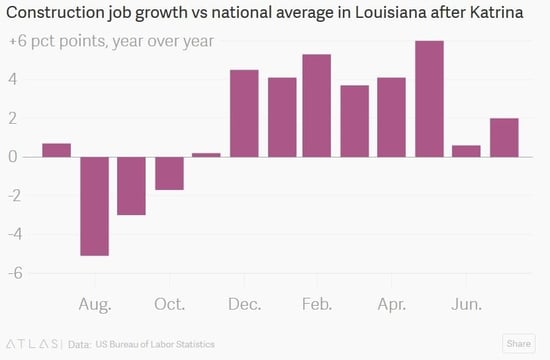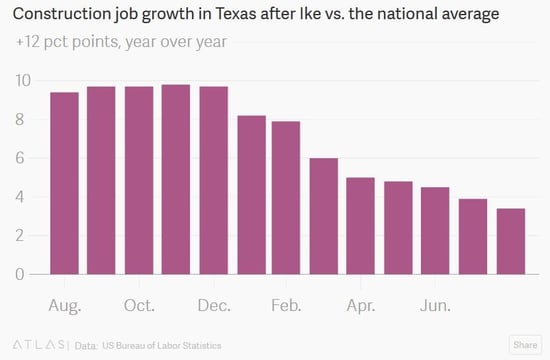4 min read
Will Hurricane Harvey Dampen the Construction Boom in Texas?
John Greene
:
September 19, 2017

The countless stories, videos and images that have emerged in the wake of the devastating destruction inflicted by hurricane Harvey upon Texas represent the very best of America. In what has been described as a “thousand-year storm,” Harvey dumped nearly four feet of rain and caused catastrophic flooding in parts of Texas, and the storm is responsible for over 60 deaths. The full scale of Harvey’s destruction is still being assessed weeks after it made landfall.
Despite the unfathomable destruction of such a storm, images of America in action—neighbors helping neighbors, the young helping the old, the strong helping the infirmed—symbolize the steadfast perseverance of the American spirit. When adversity befalls us, whether it is natural or man-made, we have a uniquely American ability to unite, forge ahead and overcome. Texas is well underway with the massive cleanup, and the widespread rebuilding effort will begin thereafter. Texans are tough and Texans are “doers;” it’s not a matter of “how,” but “when” the huge rebuild will begin.
There is a general belief that a massive infrastructure program in the wake of a natural disaster like Harvey will yield a net direct increase in jobs and every other economic indicator on the planet. The notion that a rebuilding effort will create a significant, localized demand for labor and building materials is not incorrect, but what can recent history teach us about how these events can impact the larger labor market?
Recent Gulf Coast Hurricanes
Following Hurricane Katrina in 2005, construction jobs in Louisiana grew at a slower pace than the national average. However, five months into the rebuilding effort, the state saw year-over-year gains. In the year following Katrina’s landfall, Louisiana gained 7,800 construction jobs—an increase of 6.4 percent, which is significant for an area that has not experienced the same housing-starts boom seen in other parts of the US South.

Timing also has a lot to do with drawing accurate conclusions from the construction data. After Hurricane Ike made landfall in Texas in September 2008, year-over-year construction job growth in the state significantly beat the national average for the following 12+ months. However, Ike hit right before the housing bubble burst and the Great Recession began to take its toll on the international economy. While localized construction took place in the wake of Ike’s damage, the larger economic picture has to be considered when analyzing the data. As thousands of homebuilders were losing their jobs across the country, construction workers in Texas were losing them less quickly. Over the course of the year, over 94,000 construction jobs were lost in Texas.

In our coverage of the most recent housing starts data, we noted that some of the nation’s hottest homebuilding markets are located in Texas. Prior to Harvey’s landfall, both Dallas and Houston were each on pace to build more than 40,000 homes this year, and Austin’s annualized permit activity relative to the historical norm is at 108 percent YTD. Though it’s the largest state in the lower 48, Texas’ economy has been booming.
Hindsight is 20/20 and in a year’s time, the data may prove that Harvey boosted regional job growth and GDP. However, since Texas is currently the hottest building market in the nation, the direct economic impact is likely to be insignificant. The capital and labor deployed to tackle the rebuilding effort will simply be siphoned from other areas and other infrastructure projects that will have to be delayed. In this case, it’s a matter of reallocating resources to formulate a rapid disaster response and address those most in need.
“Even a quick look at the economic data dispels the notion that the economic cost of Harvey will be offset by a bonanza of jobs,” wrote Allan Golombek, Senior Director at the White House Writers Group in a recent article. “Like most industrialized countries, the U.S. economy—with 7 million unemployed and six million job vacancies—is not short of jobs. What the construction industry and related trades need is not more work as much as more skilled workers. The Great Recession cost the industry a third of its labor force, which is still 11 percent off its pre-recession peak – a labor shortage deepened by baby boomer retirements and the crackdown on undocumented workers. By drawing workers from all over Texas, and even across the United States, the reconstruction effort will drive worker shortages, job delays and soaring construction and infrastructure costs all over the country.”
This shortage of workers is a topic we have touched on in recent months and is something that has been a point of concern for construction companies across the country. Golombek cites some sobering statistics about larger US labor trends and Texas in particular:
- Even before Harvey hit, more than two-thirds of Texas construction companies said they were having a hard time filling hourly craft worker positions, in a survey conducted by the Associated General Contractors of America (AGCA). The worker shortage has driven Texas construction companies to raise their pay scales, offer bonuses, prolong estimated completion times, and even pass on some projects.
- About 225,000 construction jobs went unfilled in June. A survey by the National Association of Home Builders found that 70 percent of builders reported difficulty hiring carpenters, over 60 percent attracting masons, and more than half finding electricians, plumbers, painters, and roofers.
- A national survey released by the Associated General Contractors of America found 70 percent of respondents had a "hard time" filling skilled labor positions.
Construction Needs
Current estimates by the Texas Department of Public Safety note that roughly 40,000 homes suffered major damage and will require extensive renovations due to hurricane Harvey; nearly 7,000 homes were totally destroyed. This astounding number exceeds Houston’s total housing starts for the entire year and does not include all of the other commercial and government-owned real estate—as well as personal property like automobiles—that has been damaged or destroyed since Harvey made landfall.
In addition to an expanded labor force, the efforts to rebuild portions of flood-ravaged Texas in the wake of Harvey will require massive amounts of construction materials. Though estimates vary, APA – the Engineered Wood Association based in WA noted in 2012 that the average American residential housing unit required:
- 11,913 board feet of lumber and engineered wood
- 9,834 square feet of structural panels
- 83 square feet of nonstructural panels
These estimates are consistent with others across the building industry and they illustrate the enormous amounts of lumber and other wood products that go into constructing an average residence. When accounting only for the rebuilding of totally destroyed homes in the wake of hurricane Harvey, the need will exceed 84 million board feet of lumber alone, approximately half the annual production of an average southern sawmill.
If there is an enormous shift in resources away from Houston’s new-housing market to satisfy the immediate need of repairing damaged homes, the net effect to local GDP will be virtually zero. The temporary spike in lumber demand will also result in essentially re-routing already allocated resources from a booming housing market. Golombek adds that, “Rebuilding after Hurricane Harvey is a matter of running just to stay in place. There are times when one must do that. Rebuilding afterwards will lead to little, if any, net increase in jobs, much less wealth. Any growth in GDP will be illusory, merely restoring existing sources of wealth. Increases in Houston’s GDP will simply be diverted from growth that would have occurred elsewhere.”
But this is what makes America unique on so many levels: we have the resources and flexibility to accomplish virtually anything we can envision, yet we often put those visions aside to focus on the immediate needs of those in harm’s way. This sheer determination grounded by a dedication to benevolence best embodies the American spirit, which will ensure that Texas recovers in the wake of hurricane Harvey.





